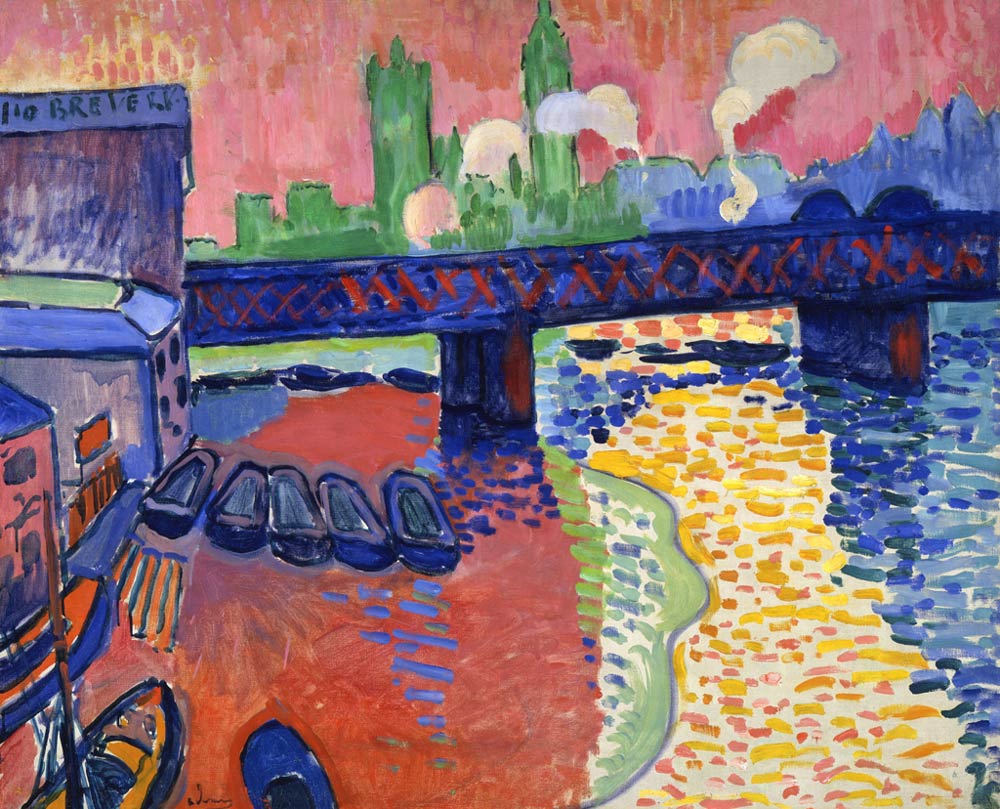| André Derain | |
|---|---|
 |
|
| Born | June 10, 1880 Chatou, Yvelines, Île-de-France |
| Died | Sept. 8, 1954 (at age 74) Garches, Hauts-de-Seine, Île-de-France |
| Nationality | French |
| Education | Académie Camillo, Académie Julian |
| Movement | Fauvism |
| Field | Painting, Sculpture |
| Works | View Complete Works |
André Derain was born on June 10, 1880 in an affluent commune region west of Paris, France. At the age of 18 he took a painting class conducted by Eugene Carriere while studying to become an engineer at the Academie Camillo. It was there that he first met Henri Matisse. Two years later he would come to share a studio with Maurice de Viaminck. His first landscapes were created at this location around 1900.
The beginning of his career was interrupted after he was called to duty by the French Army in 1901. Mr. Derain served in the military for 3 years. After his release, his friend Henry Matisse lobbied André’s parents to allow their son to pursue his true love of art as opposed to concentrating on becoming an engineer. His mother and father subsequently relented to the Matisse idea and Derain enrolled at the Academie Julian in Paris.
Art Form
 Derain worked with Matisse in the summer of 1905 on the shores of the Mediterranean in southern France. He produced very unique paintings that were a short time later shown as part of the Salon d’ Automne. The bright and unusual color combinations of these works led critics to describe the paintings as “les Fauves”. The English translation is “wild beasts.” However, the attention given these pieces was widespread and eventually led to the art form being dubbed “Fauvism.”
Derain worked with Matisse in the summer of 1905 on the shores of the Mediterranean in southern France. He produced very unique paintings that were a short time later shown as part of the Salon d’ Automne. The bright and unusual color combinations of these works led critics to describe the paintings as “les Fauves”. The English translation is “wild beasts.” However, the attention given these pieces was widespread and eventually led to the art form being dubbed “Fauvism.”
Shortly thereafter, a respected art dealer by the name of Ambroise Vollard commissioned Derain to travel to London and compose a series of the city’s landscape. The result of this assignment was a collection of 30 paintings including scenes of the Tower Bridge and Thames. The vibrant colors and bold compositions were heralded as exceeding the likes of Monet and Whistler who had previously painted scenes of the English city.
 In particular his interpretations of the Thames, he used a technique employing multiple dots, which came to be known as Pointillism. His separation of colors provided a wonderful sensation of the sunlight flickering off the water, which is an art form deemed as Divisionism.
In particular his interpretations of the Thames, he used a technique employing multiple dots, which came to be known as Pointillism. His separation of colors provided a wonderful sensation of the sunlight flickering off the water, which is an art form deemed as Divisionism.
When an art dealer purchased Derain’s entire collection in 1907, the artist found financial stability at age 27. With this, he moved to Montemartre to be near another artist he had befriended by the name of Pablo Picasso. In Montemartre, he also began to experiment with sculptures and moved from his Fauvism period to one of Cubism. At this point he was inspired by the works of Paul Cezanne. Derain also began to show an inclination towards the Old Masters in his art. 1911 to 1914 became known as his gothic period.
Later Life
 Derain’s livelihood was once again interrupted in 1914 by the military, when he was mobilized to serve during World War One. This portion of his life lasted until 1919. Upon his release from the Army, after the war, he was heralded as a traditionalist and a leader in the Classism movement. Also during this time period he produced a variety of projects including book illustrations and ballet designs. The high point in his career may have been being awarded the Carnegie Prize in 1928. A low point occurred in 1941 when he made a visit to Nazi Germany during that country’s occupation of France, which brought accusations of collaboration from many Parisians.
Derain’s livelihood was once again interrupted in 1914 by the military, when he was mobilized to serve during World War One. This portion of his life lasted until 1919. Upon his release from the Army, after the war, he was heralded as a traditionalist and a leader in the Classism movement. Also during this time period he produced a variety of projects including book illustrations and ballet designs. The high point in his career may have been being awarded the Carnegie Prize in 1928. A low point occurred in 1941 when he made a visit to Nazi Germany during that country’s occupation of France, which brought accusations of collaboration from many Parisians.
Derain died in 1954 at the age of 74 as a result of being struck by a motor vehicle on a French street.